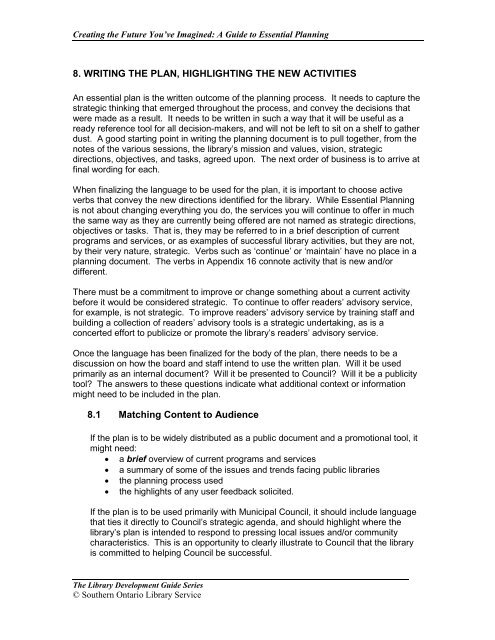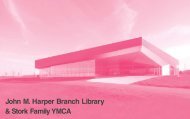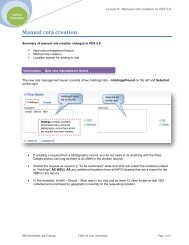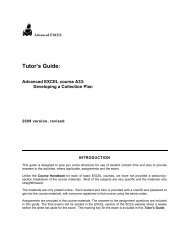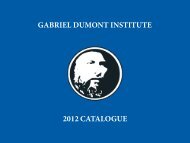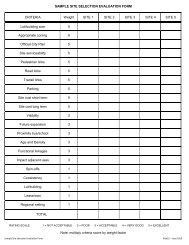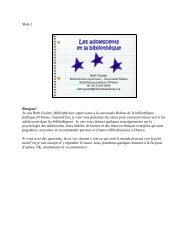Writing the Plan, Highlighting the New Activities - Southern Ontario ...
Writing the Plan, Highlighting the New Activities - Southern Ontario ...
Writing the Plan, Highlighting the New Activities - Southern Ontario ...
Create successful ePaper yourself
Turn your PDF publications into a flip-book with our unique Google optimized e-Paper software.
Creating <strong>the</strong> Future You’ve Imagined: A Guide to Essential <strong>Plan</strong>ning<br />
8. WRITING THE PLAN, HIGHLIGHTING THE NEW ACTIVITIES<br />
An essential plan is <strong>the</strong> written outcome of <strong>the</strong> planning process. It needs to capture <strong>the</strong><br />
strategic thinking that emerged throughout <strong>the</strong> process, and convey <strong>the</strong> decisions that<br />
were made as a result. It needs to be written in such a way that it will be useful as a<br />
ready reference tool for all decision-makers, and will not be left to sit on a shelf to ga<strong>the</strong>r<br />
dust. A good starting point in writing <strong>the</strong> planning document is to pull toge<strong>the</strong>r, from <strong>the</strong><br />
notes of <strong>the</strong> various sessions, <strong>the</strong> library’s mission and values, vision, strategic<br />
directions, objectives, and tasks, agreed upon. The next order of business is to arrive at<br />
final wording for each.<br />
When finalizing <strong>the</strong> language to be used for <strong>the</strong> plan, it is important to choose active<br />
verbs that convey <strong>the</strong> new directions identified for <strong>the</strong> library. While Essential <strong>Plan</strong>ning<br />
is not about changing everything you do, <strong>the</strong> services you will continue to offer in much<br />
<strong>the</strong> same way as <strong>the</strong>y are currently being offered are not named as strategic directions,<br />
objectives or tasks. That is, <strong>the</strong>y may be referred to in a brief description of current<br />
programs and services, or as examples of successful library activities, but <strong>the</strong>y are not,<br />
by <strong>the</strong>ir very nature, strategic. Verbs such as ‘continue’ or ‘maintain’ have no place in a<br />
planning document. The verbs in Appendix 16 connote activity that is new and/or<br />
different.<br />
There must be a commitment to improve or change something about a current activity<br />
before it would be considered strategic. To continue to offer readers’ advisory service,<br />
for example, is not strategic. To improve readers’ advisory service by training staff and<br />
building a collection of readers’ advisory tools is a strategic undertaking, as is a<br />
concerted effort to publicize or promote <strong>the</strong> library’s readers’ advisory service.<br />
Once <strong>the</strong> language has been finalized for <strong>the</strong> body of <strong>the</strong> plan, <strong>the</strong>re needs to be a<br />
discussion on how <strong>the</strong> board and staff intend to use <strong>the</strong> written plan. Will it be used<br />
primarily as an internal document? Will it be presented to Council? Will it be a publicity<br />
tool? The answers to <strong>the</strong>se questions indicate what additional context or information<br />
might need to be included in <strong>the</strong> plan.<br />
8.1 Matching Content to Audience<br />
If <strong>the</strong> plan is to be widely distributed as a public document and a promotional tool, it<br />
might need:<br />
• a brief overview of current programs and services<br />
• a summary of some of <strong>the</strong> issues and trends facing public libraries<br />
• <strong>the</strong> planning process used<br />
• <strong>the</strong> highlights of any user feedback solicited.<br />
If <strong>the</strong> plan is to be used primarily with Municipal Council, it should include language<br />
that ties it directly to Council’s strategic agenda, and should highlight where <strong>the</strong><br />
library’s plan is intended to respond to pressing local issues and/or community<br />
characteristics. This is an opportunity to clearly illustrate to Council that <strong>the</strong> library<br />
is committed to helping Council be successful.<br />
The Library Development Guide Series<br />
© Sou<strong>the</strong>rn <strong>Ontario</strong> Library Service
Creating <strong>the</strong> Future You’ve Imagined: A Guide to Essential <strong>Plan</strong>ning<br />
A planning document that is intended to be used internally need not have <strong>the</strong>se<br />
additional sections, but may, on <strong>the</strong> o<strong>the</strong>r hand, have more detailed descriptions of<br />
<strong>the</strong> tasks related to each objective, including responsibility, timeline, and even<br />
budget ramifications. These details are necessary, regardless, but whe<strong>the</strong>r or not<br />
<strong>the</strong>y appear in <strong>the</strong> planning document itself depends on <strong>the</strong> intended audience for<br />
<strong>the</strong> plan. A number of libraries end up deciding to have two versions of <strong>the</strong> plan: a<br />
glossy, succinct version as a promotional tool, and a lengthier, more detailed<br />
version for internal use and accountability. O<strong>the</strong>r libraries have chosen to endorse<br />
one plan that meets <strong>the</strong> needs of internal and external readers. Staff and board, in<br />
this case, are also given access to an accompanying document that provides <strong>the</strong><br />
more operational details necessary for implementation of <strong>the</strong> plan.<br />
8.2 Making <strong>the</strong> <strong>Plan</strong> a Useful Document<br />
Whe<strong>the</strong>r or not <strong>the</strong> plan will be distributed as a promotional tool, it needs to exist in<br />
a form that lends itself to serving as a ready reference tool for board and staff. This<br />
means that <strong>the</strong> plan is written in a style and produced in a format that makes it easy<br />
to digest, easy to find things, and easy to see how everything fits toge<strong>the</strong>r. If it is<br />
not easy to use, it will not be widely used.<br />
When a plan is well written, it contributes to effective implementation, resulting in<br />
real change in improved service and/or increased capacity to deliver service.<br />
Effective plans are developed and written in a manner that is:<br />
• Futuristic: responsive to emerging trends and indications of <strong>the</strong> future reality<br />
• Desirable: appealing and worth aspiring to<br />
• Imaginable: conveying a picture of <strong>the</strong> desired future<br />
• Practical: full of concrete tasks with timelines and responsibility assigned<br />
• Achievable: realistic; do-able and affordable<br />
• Defensible: responsive to service demands and external influences, (ie) <strong>the</strong><br />
plan makes sense, given <strong>the</strong> circumstances<br />
• Measurable: objective language defines success through <strong>the</strong> use of<br />
milestones and quantitative indicators<br />
• Memorable: concise and relevant; easy to apply<br />
• Flexible: adaptable to new ideas and/or changing circumstances.<br />
It can be a worthwhile exercise for <strong>the</strong> board to collectively apply <strong>the</strong>se principles to<br />
<strong>the</strong> written document, before finalizing it, assessing it for overall clarity, alignment,<br />
and effectiveness. See Appendix 17 for a checklist version of <strong>the</strong> above list.<br />
The Library Development Guide Series<br />
© Sou<strong>the</strong>rn <strong>Ontario</strong> Library Service


